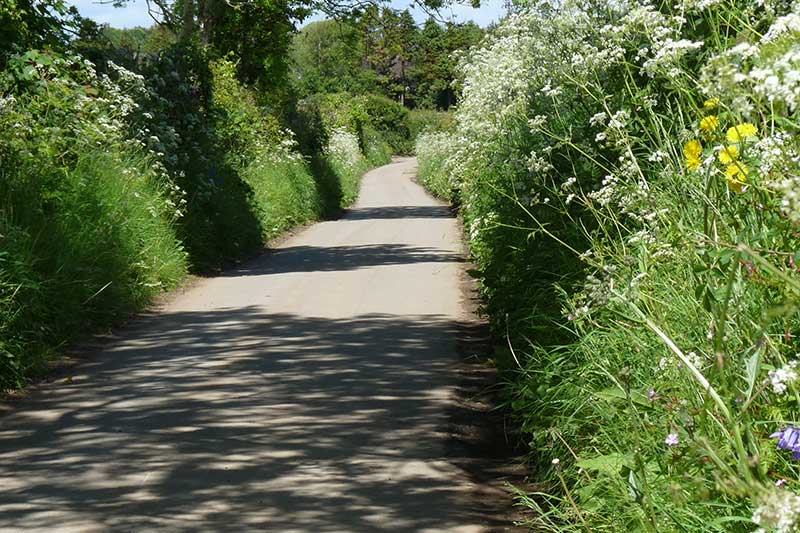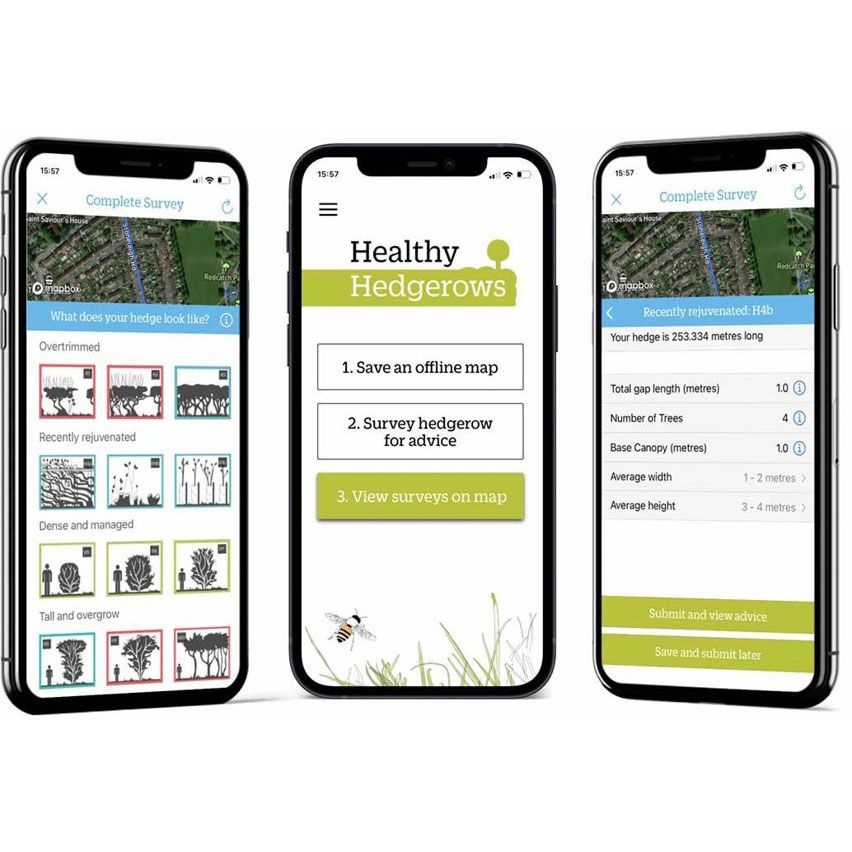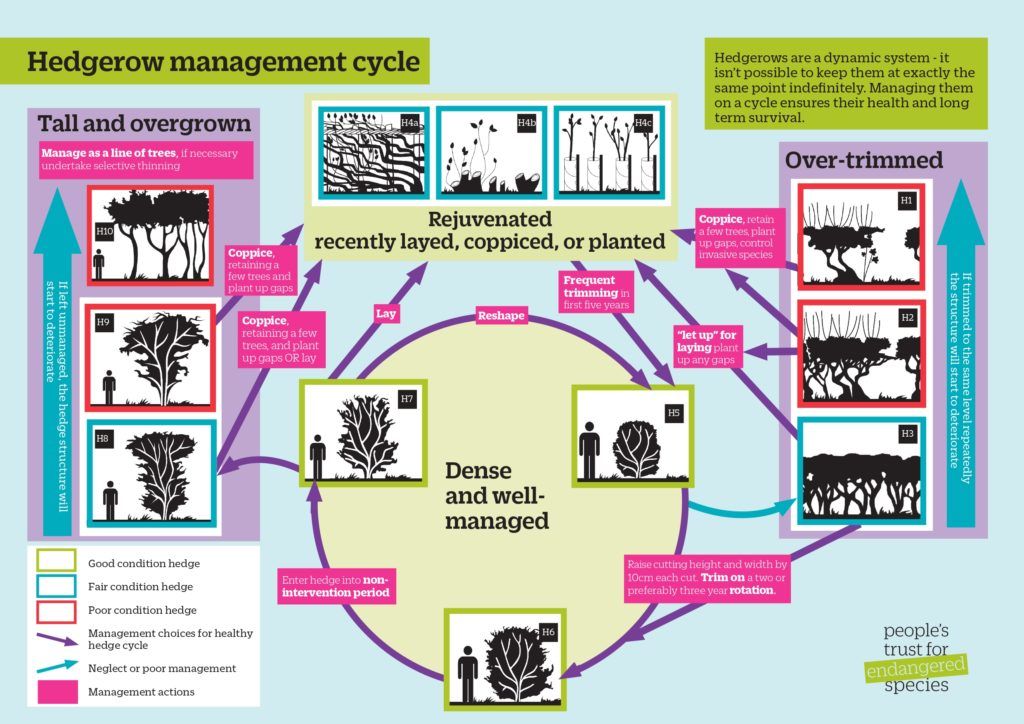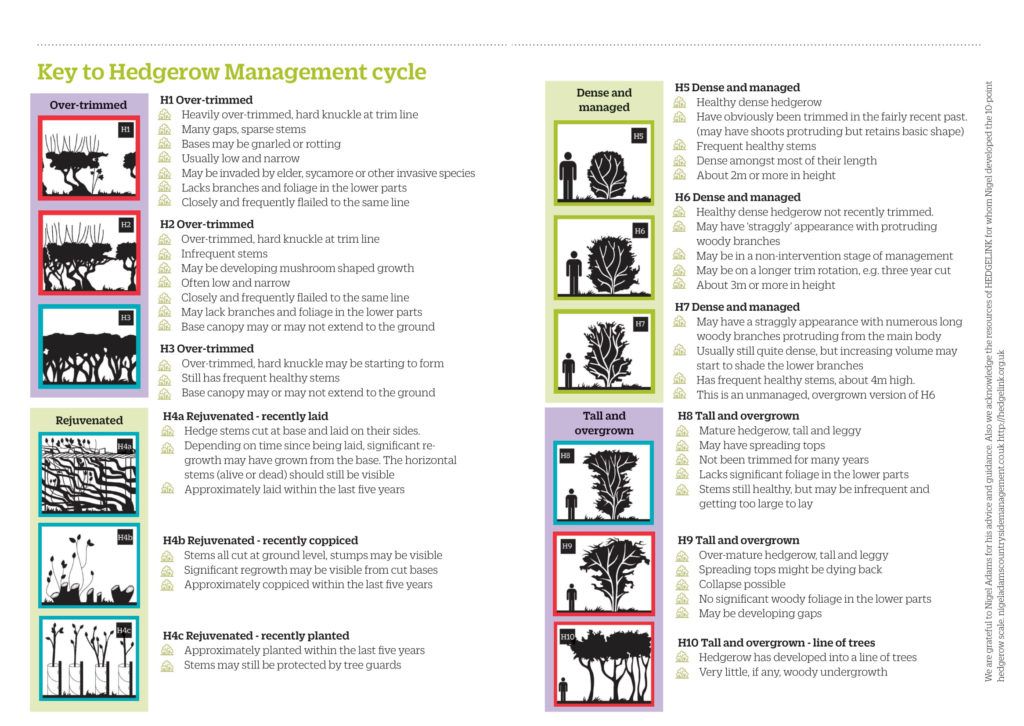Top tips for managing hedgerows

Hedgerows are a dynamic habitat that require management. Managing hedgerows on a cycle ensures their health and long term survival. Here are some top tips for managing hedgerows.
Manage a hedge on a cycle
Hedgerows are a dynamic organism, just like the individual plants from which they are created. They consequently require a dynamic management approach which respects their position in the hedgerow management cycle. The ultimate goal in hedge management is to create a thick, dense hedgerow. This will have high wildlife and nature value, while providing many benefits to people.
Regardless of the annual management employed, the lower parts of a hedge’s vegetation will eventually thin, and it will require rejuvenation. A hedge can be rejuvenated through laying or coppicing. This only needs to be done every 40+ years to keep the hedge healthy and valuable for wildlife. See the hedgerow management cycle for more information. The hedgerow management 10 point scale on which this illustration is based was created by Nigel Adams. For more information visit Nigel Adams’s Countryside Management website here.
The different management techniques that are appropriate at different stages of the hedgerow management cycle are outlined below.
Cut hedges gradually higher and wider
When hedges are cut to the same width and height year after year, fewer flowers and fruit are produced and the food available to wildlife is reduced. Cutting to the same trim line each year also causes stem health to deteriorate. At first, a hedge managed in this way will lose its lower branches over time and become ‘leggy’ and at risk of invasion. Eventually, the hedge will lose some of the main woody stems along its length, meaning that it will become ‘gappy’ over time. If stem loss continues through over management, in some instances a hedge can be lost altogether.
Trimming slightly higher and wider each year by following a system of incremental cutting (cutting about 10cm higher and wider than the previous trim line), will help to prevent this outcome. The hedge can then be re-shaped when needed.
Care for hedgerow trees
Hedgerow trees, especially native ones, are fantastic for wildlife and will increase both the abundance and diversity of species inhabiting a hedge. Old trees are especially valuable as their rot holes and dead wood are amazing roost sites for birds and bats. They can also provide the increasingly rare habitat needed for an incredible array of rare invertebrates.
Aim for a balance of both old, mature hedgerow trees that provide valuable deadwood habitat, and young trees that will become the mature hedgerow trees of the future. New young trees can be established by selecting suitable straight-growing stems already present in the shrub layer of a hedge and not cutting or rejuvenating these when the shrub layer is next cut or rejuvenated.
Trim at the best time for nature
Leave trimming until late winter wherever possible, ideally January or February. This allows birds and small mammals to feed on wild berries and fruit, keeping them sustained through the winter. Cutting earlier removes the majority of this food source, making the winter months harder for wildlife.
Hedges should never be cut in the bird breeding season which extends from 1st March to 31st August (unless safety reasons necessitate it). This is because cutting can disturb or destroy nests, egg clutches or chicks, all of which are protected by law.
Avoid trimming every year
The good news is that, it’s best not to cut every year! Cutting once every two or preferably three years increases flower and berry abundance, as these are often only produced on two year and older stems.
The benefit of this is that hedges can be cut on rotation, so that only half or a third of hedges are cut in any one year. Rather than cutting all of these hedges in one block, aim to distribute rotational cutting across a site so that the resources in an area aren’t all removed in one go. An alternative is cutting just one side of each hedge every year. This will reduce the cutting time and leave flowers and berries on each hedge. Avoid cutting all hedge sides of a particular compass orientation in one year, e.g. all south-facing sunny hedge sides.
If space allows, a hedge can also be entered into a period of non-intervention where it’s not cut for a number of years. This allows it to grow out into a big, beautiful hedge that provides lots of resources for wildlife. However, as soon as the density of vegetation at the base starts to thin, the hedge will need rejuvenation through laying or coppicing.
Plant up gaps
Gaps in hedges reduce the total area of the hedge habitat, as well as their value as a wildlife corridor. Even small gaps in a hedgerow can be an obstacle to dormouse dispersal which can lead to isolated populations more at risk of local extinction.
Any gaps can be planted up with a range of native shrub or tree species. The best time to plant up gaps is when rejuvenating the hedge. Young whips can be protected when doing this, in areas where they are at a high risk of being foraged. Increasing the number of plant species in a hedge will help to provide food in the form of flowers or fruit throughout the year.
Native shrubs and woody species provide habitat for more insect and animal species than those that are introduced from abroad, as more of our native wildlife have adapted to eat them.
Manage newly planted / rejuvenated hedges
Newly planted or recently rejuvenated (coppiced/layed) hedges require a slightly different management approach to already established hedges. Yearly trimming encourages the young stems to put more effort into the branching growth. Each year, the hedge can be trimmed slightly higher and wider than the previous trim line. This will lead to the growth of dense vegetation along the hedge and down to the ground, which is great for wildlife.
This yearly cutting can be carried out for the first 5 years after planting or rejuvenating a hedge, or until a dense hedge structure has been achieved.
Health-check your hedgerows

The Healthy Hedgerows survey provides instant feedback about the health of the hedge and bespoke management advice. The data that you contribute helps us to understand the overall health of hedgerows at a national scale so that we are able to direct our conservation work. Learn more:


